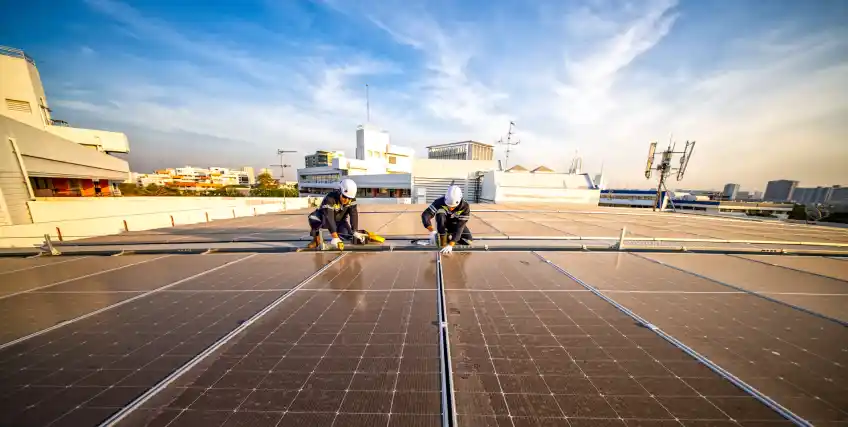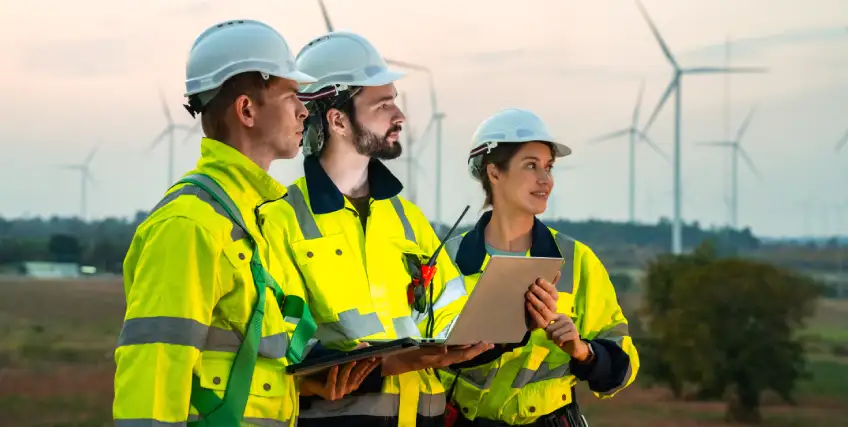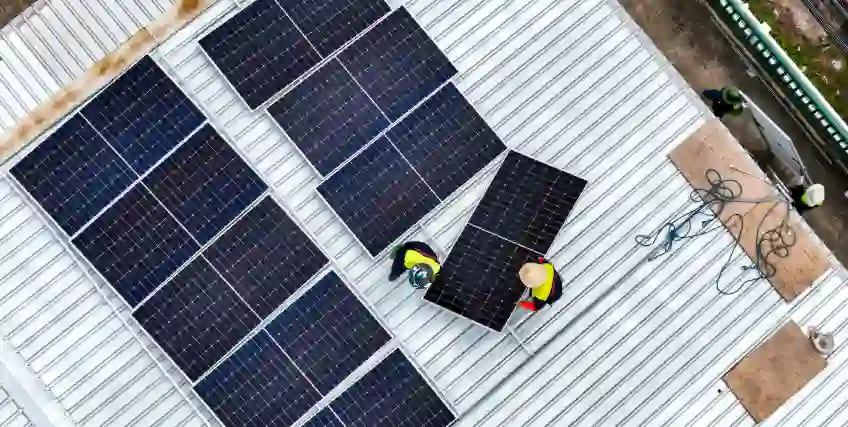Clean Energy, Funded Right:
Your Guide to Energy Project Financing
Looking for Business Financing?
Apply now for flexible business financing. Biz2Credit offers term loans, revenue-based financing, and commercial real estate loans to qualified businesses.
Set up a Biz2Credit account and apply for business financing
The demand for clean and reliable energy is driving significant investments in energy project financing. Whether it’s solar, wind, or energy storage systems, developers need robust financial solutions to meet project goals. From reducing upfront costs to unlocking long-term value through power purchase agreements (PPAs) and tax credits, there are many ways to fund a project efficiently.
This guide explores how renewable energy project financing works, what options are available, and how developers can navigate the process.
What is Energy Project Financing?
Energy project financing refers to the structured funding of utility-scale or standalone renewable initiatives like solar projects, wind farms, or battery storage systems. These projects often involve multiple stakeholders, including developers, lenders, and equity investors.
The approach allows for the non-recourse financing of high-cost projects. This means the project's cash flow, not the developer's assets, secures the loan. Lenders assess technology risks, repayment capability, and forecast tariffs to determine terms.
Project financing spreads risk across parties. It also encourages more private capital to enter the clean energy space, boosting long-term sustainability goals and accelerating the energy transition.
How Energy Project Financing Works
Energy project financing works by structuring capital around the project’s future revenue instead of the developer’s balance sheet. This approach is especially helpful for renewable energy projects like solar farms, wind plants, and battery storage facilities. First, the developer secures site permits, interconnection studies, and technical feasibility. These documents are vital to proving the project is viable. Next, they approach financial institutions or solar farm financing companies with detailed financial projections and project plans.
To reduce technology risks, developers often partner with experienced vendors. Lenders assess forecasted energy output, tariffs, and repayment ability. Projects with long-term power purchase agreements (PPAs) and offtake contracts are viewed more favorably.
Funding can be structured as non-recourse, meaning only the project’s cash flow is used to repay the loan. Additional support like tax equity or grants can bridge capital gaps.
Types of Projects That Qualify
Energy project financing can support a range of clean energy and infrastructure developments. Projects that show strong revenue potential and regulatory readiness are often eligible.
1. Utility-scale solar farm
These are large installations that supply power to the grid. Often backed by PPAs, they qualify for solar farm loans and tax credits.
2. Wind energy projects
Onshore and offshore wind projects above 30 megawatts attract non-recourse financing with support from federal incentives and stable offtake.
3. Battery storage and energy storage systems
Standalone or hybrid systems improve grid reliability. They often receive funding for solar projects with integrated storage capacity.
4. Energy efficiency retrofits
These include LED, HVAC, and industrial process upgrades. Often funded via leases or energy performance contracts.
5. Bioenergy and waste-to-energy
These systems convert waste or biomass into power. Qualify under renewable energy project financing when tied to long-term utility contracts.
Popular Financing Options Available for Energy Project Financing
There are many financing structures available depending on your project type, scale, and risk tolerance. These options help cover upfront costs and long-term capital needs.
1. Debt Financing
This involves borrowing funds from a lender, repaid with interest over time. In energy project financing, lenders evaluate expected cash flow from the project. Long-term PPAs make projects more attractive by ensuring revenue. Interest rates depend on credit risk, location, and project economics.
2. Equity Financing
Developers can bring in equity investors in exchange for ownership stakes. This works well for early-stage clean energy projects with high growth potential. While it reduces debt burden, it can dilute control.
3. Tax Equity Partnerships
Popular for solar energy and wind, these partnerships monetize federal tax credits. Investors fund a portion of the project in exchange for tax benefits, such as the Investment Tax Credit (ITC) or Production Tax Credit (PTC).
4. Grants and Incentives
Government-backed funding reduces project risk. Programs like USDA REAP or DOB loan guarantees support rural and sustainable energy projects.
5. PPAs and Offtake Agreements
These long-term energy sales contracts with utilities or corporations make renewable energy projects more financeable by offering stable income streams.
Eligibility Criteria and Key Considerations
Qualifying for energy project financing depends on meeting several financial, technical, and regulatory benchmarks.
1. Offtake Agreements
Projects must have signed PPAs or similar contracts with utilities or large buyers. These agreements ensure long-term revenue and help assess debt service capacity.
2. Permits and Regulatory Approvals
All required environmental and grid interconnection permits should be secured. This reduces development risk and attracts solar farm financing companies.
3. Feasibility and Cash Flow Forecasting
Detailed studies on energy output, tariffs, and operations must be included. Financial institutions want clear models of projected cash flow and repayment schedules.
4. Developer Experience
Lenders prefer project sponsors with a track record in energy or infrastructure. Past success reduces perceived execution risk.
5. Technology Used
Bankable, proven technologies are preferred. Projects using new or untested systems may face higher interest rates or underwriting hurdles.
Each of these factors plays a critical role in determining whether a lender or investor will back your renewable energy buildout.
Pros and Cons of Energy Project Financing
Here’s a breakdown of the key benefits and challenges of energy project financing.
Pros
Access to Capital for Large-Scale Projects
Energy project financing allows developers to raise the substantial capital required for large-scale renewable energy projects. Whether building solar farms, wind energy systems, or battery storage, funding often involves millions in upfront costs. Through a mix of debt, equity, and grants, project sponsors can reduce capital pressure and keep the project moving. This structure ensures progress without exhausting the company’s balance sheet and supports broader goals of clean energy deployment and sustainability.
Non-Recourse Financing Reduces Risk
One of the most important benefits of energy project financing is the use of non-recourse structures. In such cases, the lender cannot claim the developer’s personal or corporate assets in the event of project failure. The loan is repaid solely through project-generated cash flow. This attracts more risk-tolerant financial institutions and provides peace of mind to developers, especially for high-cost ventures like utility-scale solar projects or energy storage systems.
Tax Credits and Tax Equity Partnerships
Projects can significantly reduce capital costs by leveraging tax credits such as the Investment Tax Credit (ITC) or Production Tax Credit (PTC). These can be monetized through tax equity partnerships, where investors provide funding in exchange for tax benefits. This approach is especially effective for solar energy and wind developers, enabling access to external capital and improved return on investment. For many renewable energy projects, this support is a cornerstone of financial planning and cash flow optimization.
Long-Term Revenue through PPAs
A stable, long-term power purchase agreement (PPA) provides predictable income for 10 to 25 years. This revenue visibility is essential for securing energy project financing and improving the project’s credit profile. It helps developers forecast repayment and debt service, reduces investor risk, and makes the project more attractive to lenders. PPAs are especially common in solar projects and wind energy systems, where a utility or corporate buyer agrees to purchase electricity at pre-agreed rates.
Cons
Complex and Lengthy Due Diligence
Obtaining energy project financing involves a highly detailed due diligence process. Developers must present feasibility reports, environmental approvals, interconnection studies, and financial forecasts. This can take months and may require collaboration with lawyers, engineers, and financial institutions. Stakeholders, including equity investors and tax equity partners—may demand deeper insight into technology risks, construction timelines, and tariff forecasts. All of this can delay project start dates and add to project costs.
High Upfront Development Costs
Before securing funding, developers must often spend heavily on project development. These include costs for engineering studies, permits, land acquisition, legal advice, and utility coordination. These upfront costs are necessary to prove the project’s bankability and are often non-refundable. For smaller developers or those entering the renewable energy space for the first time, these financial demands can be a barrier to accessing solar farm loans or similar financing options.
Equity Dilution and Loss of Control
To reduce debt exposure, many developers bring in equity investors. While this can help secure needed capital, it often comes at the cost of ownership and control. Investors may seek active roles in management or demand changes in project strategy. For smaller sponsors or first-time borrowers, this could lead to a loss of influence over important decisions. It’s essential to weigh the trade-off between financial support and strategic autonomy when considering project financing options.
Government Support and Tax Incentives
Government programs make energy project financing more accessible and attractive by offering tax relief and low-interest funding.
1. Investment Tax Credit (ITC)
Covers up to 30% of qualified solar energy project costs. Widely used in residential, commercial, and utility-scale sectors.
2. Production Tax Credit (PTC)
Offered for wind, hydro, and geothermal, the PTC gives ongoing benefits based on output in kilowatt-hours. Supports long-term sustainability.
3. MACRS Depreciation
Allows accelerated asset depreciation, reducing taxable income. Improves investor returns for solar projects and storage systems.
4. USDA REAP Loans and Grants
Designed for agricultural and rural developers, especially for solar farm loans and energy efficiency upgrades.
5. DOE Loan Programs
Offer low-cost capital with flexible underwriting for high-impact renewable energy projects and battery storage systems.
These benefits encourage developers and lenders alike to invest in clean energy.
Trusted by Thousands of Small Business Owners in America.**
Simply because we get what you go through to build a business you believe in.
**Disclaimer: All stories are real, as told by real business owners. Customers do not receive monetary compensation for telling their stories.
From One Entrepreneur to Another: We Get You
We understand what's behind building a business you believe in.
All stories are real, as told by real business owners. Customers do not receive monetary compensation for telling their stories.



Articles on Energy Project Financing
Renewable Energy Project Financing: Your Guide to Sustainable Business Growth
Small business owners often turn to renewable energy to lower operating expenses and improve sustainability.
Popular Financing Options for Your Next Commercial Energy Project
As costs continue to rise and the climate impact is felt more broadly, many businesses are putting a greater emphasis
Energy Project Loans vs. Grants: Which Is Right for Your Business?
Renewable energy projects are big business. Globally, the renewable energy market is worth an estimated $1.5 trillion.
Frequently Asked Questions on Energy Project Financing
1. How is energy project financing different from traditional loans?
Energy project financing is typically non-recourse, meaning repayment comes solely from the project's future cash flow rather than the developer’s credit or assets. Traditional loans, on the other hand, rely heavily on borrower credit history and collateral. In project financing, long-term contracts like power purchase agreements (PPAs) and technical feasibility reports matter more than personal guarantees. This model works especially well for solar energy, wind projects, and other clean energy developments that offer consistent, predictable revenue.
2. What risks should developers consider before applying for energy project financing?
Developers should evaluate technology risks, potential delays, changing tariffs, and policy shifts. These factors can affect project costs, returns, and lender interest. Regulatory changes, such as reductions in tax benefits or utility connection rules, may also impact long-term viability. Developers should also consider construction readiness, vendor reliability, and availability of experienced contractors. Good planning and legal due diligence can mitigate many of these risks and make energy project financing more accessible and secure.
3. How long does it take to secure energy project financing?
The timeline for energy project financing can vary from a few months to over a year. Smaller solar energy installations may secure funding in 3–6 months, especially if permits and PPAs are ready. Larger or more complex utility-scale projects can take 9–18 months due to environmental assessments, stakeholder approvals, and legal structuring. The process includes feasibility studies, credit assessments, and term sheet negotiations. Starting early and preparing comprehensive documentation can speed up funding.
4. What makes a project attractive to energy lenders and investors?
Lenders and equity investors prioritize well-structured projects with strong cash flow forecasts, signed offtake contracts like PPAs, and clear regulatory compliance. Using proven, bankable technology and having an experienced project sponsor further boosts credibility. Projects that integrate tax benefits, show environmental impact, or support clean energy goals also tend to receive better terms. The more risk mitigation and clarity you offer, the more attractive your project becomes to energy project financing partners.
5. What are the most common structures used in energy project financing?
The most common energy project financing structures include non-recourse loans, tax equity partnerships, and special purpose vehicles (SPVs). SPVs isolate project liabilities from the parent company and simplify revenue tracking. PPAs are used to secure long-term offtake and improve financing terms. Debt is usually layered with equity and government incentives to minimize repayment risk. For renewable energy developers, these hybrid structures allow better financial flexibility and alignment between investors, developers, and lenders.



